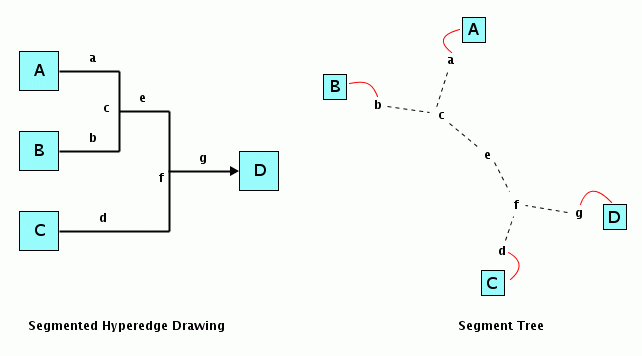An IlvSegmentedHyperEdge object has a shape that
consists of line segments. The line segments form branches that
connect all hyperedge ends. Therefore, the segments can be
connected to other segments and can be connected to hyperedge ends
at a node. We call a segment incident to a node an end segment, and the other segments the inner segments. The segments of a hyperedge
form an unrooted, undirected segment tree.

A segmented hyperedge with its segment
tree
In the figures above:
- The dashed lines indicate the segments that are incident.
- The red lines indicate which segments are connected to end nodes.
- The segments a, b, d, and g are end segments; the segments c, e, and f are inner segments.
You may be surprised that the segment tree
is undirected, even though the hyperedge may be directed. The
direction of the hyperedge comes from the fact that arrow heads are
drawn at certain end points. This direction is irrelevant for the
segment tree; that is, there is no root of the segment tree, but
each segment has several (or 0) incident segments. By starting at
an arbitrary segment, an algorithm can traverse all incident
segments recursively without running into a cycle. Therefore it is
an unrooted, undirected segment tree.
A segment is implemented by the inner class IlvSegmentedHyperEdge.Segment. To retrieve
all segments of a hyperedge, make the call shown in the following
code example.
Retrieving all segments of a hyperedge
IlvSegmentedHyperEdge seghyperedge = ...
Iterator iterator = seghyperedge.getSegments();
while (iterator.hasNext()) {
IlvSegmentedHyperEdge.Segment segment =
(IlvSegmentedHyperEdge.Segment)iterator.next();
...
}
The API of
IlvSegmentedHyperEdge.Segment
includes the methods listed in the following table.
Methods of IlvSegmentedHyperEdge.Segment
Method |
Description
|
|---|---|
Returns
the hyperedge that owns the segment. |
|
Returns
the hyperedge ends of the segment if it is an end segment. If
it returns an empty array, the segment is an inner segment. |
|
Returns
the number of incident segments. |
|
Returns
the incident segment with index i. The index of incident
segments starts at 0. |
|
Tests
whether two segments are incident. |
If two segments A and B are connected, then
A will have B as incident segment and B will have A as incident
segment. This allows traversal of the incident segments in any
direction. To avoid running into a loop, you only have to make sure
that you do not visit the segment again where you immediately came
from. The method in the following code example illustrates this
concept.
Method for traversal of incident segments
in any direction
public void visit(IlvSegmentedHyperEdge.Segment segment,
IlvSegmentedHyperEdge.Segment cameFrom)
{
...
int n = segment.getIncidentSegmentsCount();
for (int i = 0; i < n; i++) {
IlvSegmentedHyperEdge.Segment childSegment =
segment.getIncidentSegment(i);
if (childSegment != cameFrom)
visit(childSegment, segment);
}
}
...
// visit all segments reachable from startSegment
visit(startSegment, null);